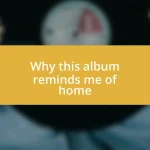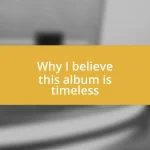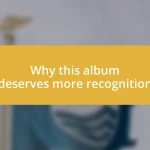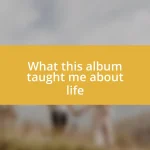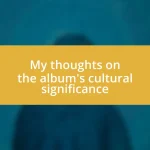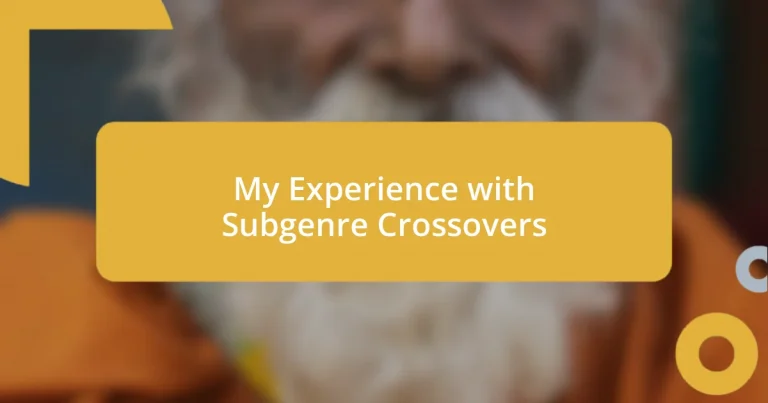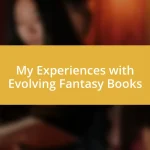Key takeaways:
- Subgenre crossovers blend elements from different genres, creating unique narratives that challenge genre boundaries and enhance emotional connections.
- Successful crossovers require a balance of tone, authentic character development, and experimentation to engage readers without losing coherence.
- Audience reception varies based on expectations and how well the cross-genre elements are portrayed, with the potential to either alienate or deeply resonate with viewers.
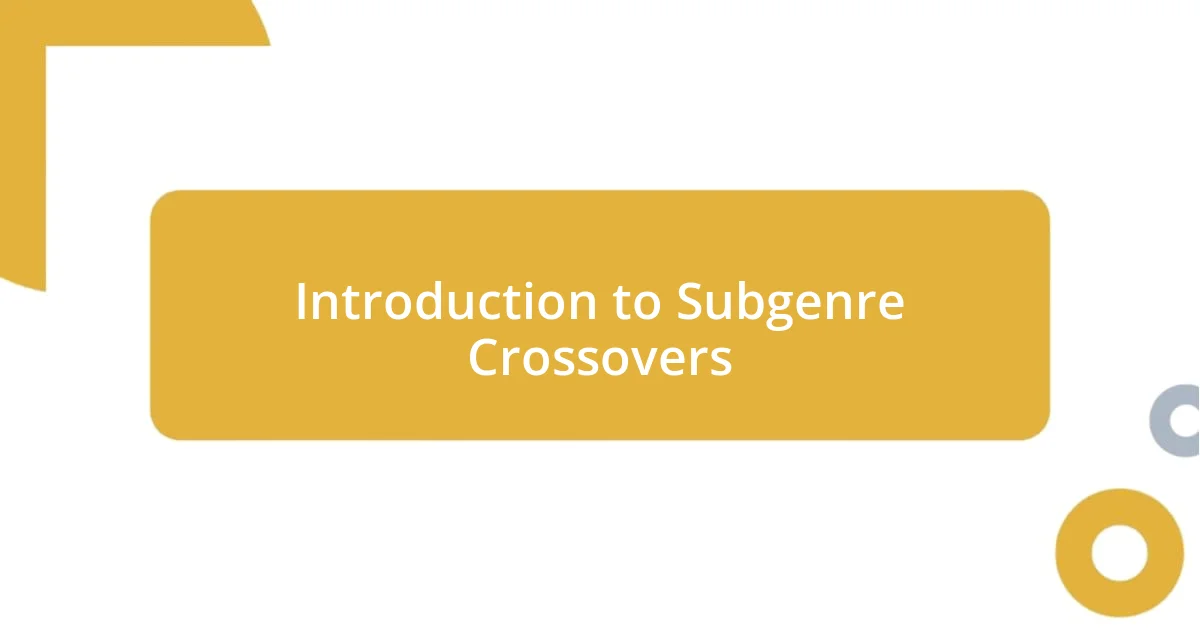
Introduction to Subgenre Crossovers
When I first stumbled upon subgenre crossovers, I was both intrigued and a bit confused. How could a horror story have elements of romance and still be terrifying? This blend of genres often leads to unexpected plot twists and character developments that keep me eagerly turning the pages.
I remember reading a book that masterfully combined science fiction with historical fiction. It was fascinating to see how the author wove futuristic technology into a historical setting. This unique mix not only broadened my understanding of both genres but also made me appreciate the creative possibilities that come with subgenre crossovers.
Have you ever found yourself engrossed in a story that felt both familiar and entirely new? That’s the beauty of subgenre crossovers; they challenge our perceptions of genre boundaries and invite us into a world where anything is possible. I find that these hybrids often resonate with readers on multiple levels, opening the door to richer narratives and deeper emotional connections.
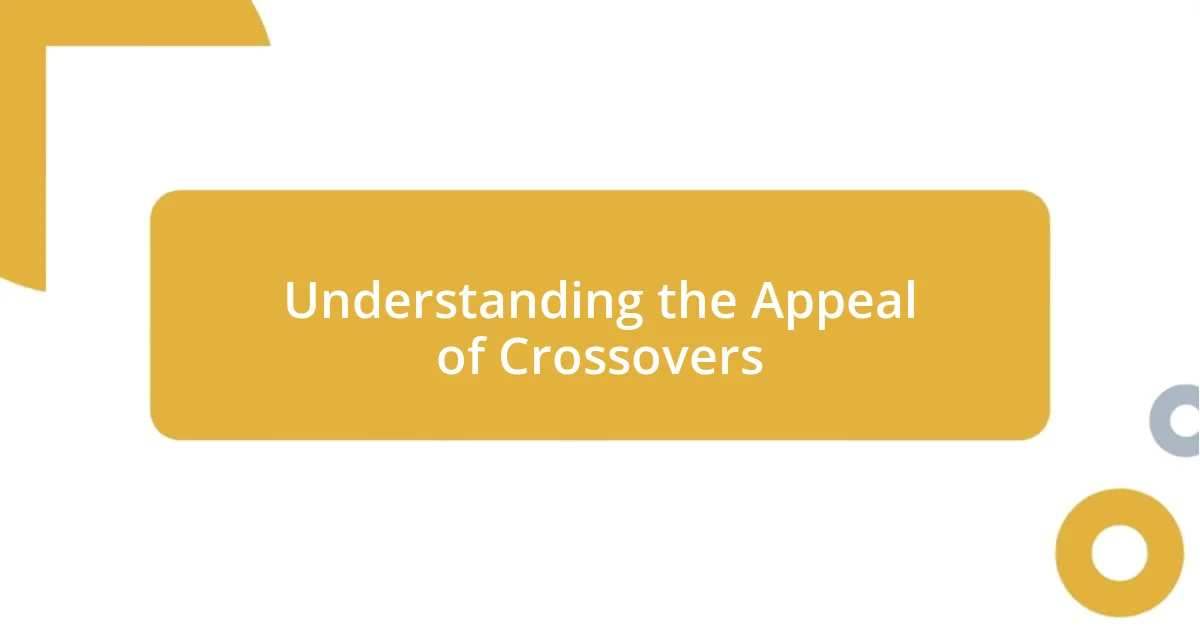
Understanding the Appeal of Crossovers
Crossovers have a unique magic that transforms how we engage with stories. I recall a time I picked up a fantasy novel that spun elements of mystery into its tapestry. Each turn of the page revealed not just enchanting creatures but also intriguing puzzles to solve. This interplay fuels my excitement and keeps my mind racing, as I never quite know what awaits me next.
The appeal of crossovers also lies in their ability to cater to diverse tastes. I have friends who love thrillers, while others are die-hard fantasy fans. When they suggested a book that combined both genres, I was skeptical. Yet, as soon as I dove in, I realized how thrilling it was to navigate through quests filled with danger and suspense. Those moments where genres fuse offer a fresh perspective that traditional narratives sometimes lack.
Finally, there’s an element of comfort in crossover stories that I cherish deeply. They often remind me of beloved childhood tales, where anything seemed possible. For instance, I remember watching animated shows that blended humor with heartfelt moments, creating a rich emotional landscape. This sentimentality invites readers to revisit those feelings while exploring uncharted territory, ultimately enhancing our connection to the story’s world.
| Aspect | Genres |
|---|---|
| Emotional Resonance | Crossovers deepen emotional connections through multifaceted narratives. |
| Diversity of Taste | They satisfy varied reader preferences by blending genres. |
| Familiar Comfort | Crossovers evoke nostalgia while inviting us into new experiences. |
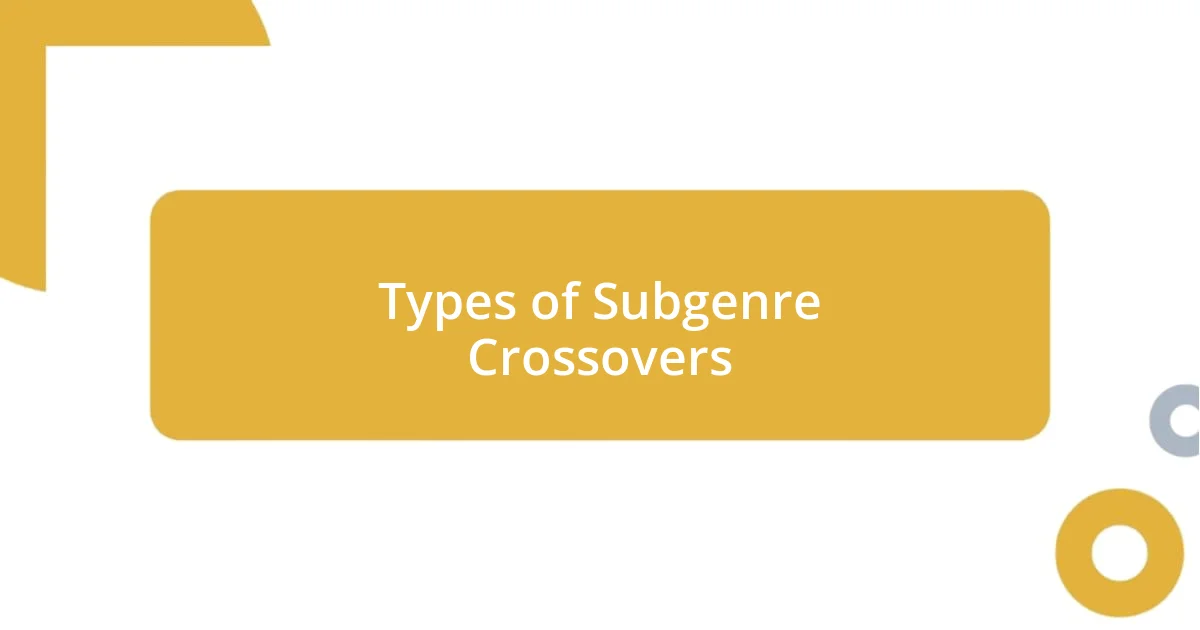
Types of Subgenre Crossovers
Subgenre crossovers come in all shapes and sizes, leading to some truly fascinating creations. For instance, I once delved into a graphic novel that blended elements of horror and comedy. The humorous banter between characters lightened the suspenseful atmosphere, creating a perfect storm of chills and laughs that kept me entertained and on edge. This duality not only made the plot compelling but also resonated with my own experiences of facing fears with a touch of humor; sometimes, it’s a good joke that helps ease the tension.
Here are some common types of subgenre crossovers:
- Fantasy and Mystery: Enchanted quests with twists and secrets to unravel.
- Science Fiction and Horror: High-tech terrors lurking in the unknown.
- Romantic Thriller: Love stories intertwined with suspense and danger.
- Historical Fiction and Fantasy: Real events mingling with magical elements, creating a vibrant retelling.
- Young Adult and Dystopian: Exploring adolescence through the lens of a crumbling society.
I remember feeling a rush of excitement when I discovered novels that deftly twined together elements of dystopian fiction with romance. For example, a book that I picked up blended teenage love with the harsh realities of a survival scenario. The desperation of the world around them heightened the romantic connection, making me root for the couple even more. In those moments, I found myself reflecting on how relationships evolve under pressure, which added a layer of depth to my reading experience.
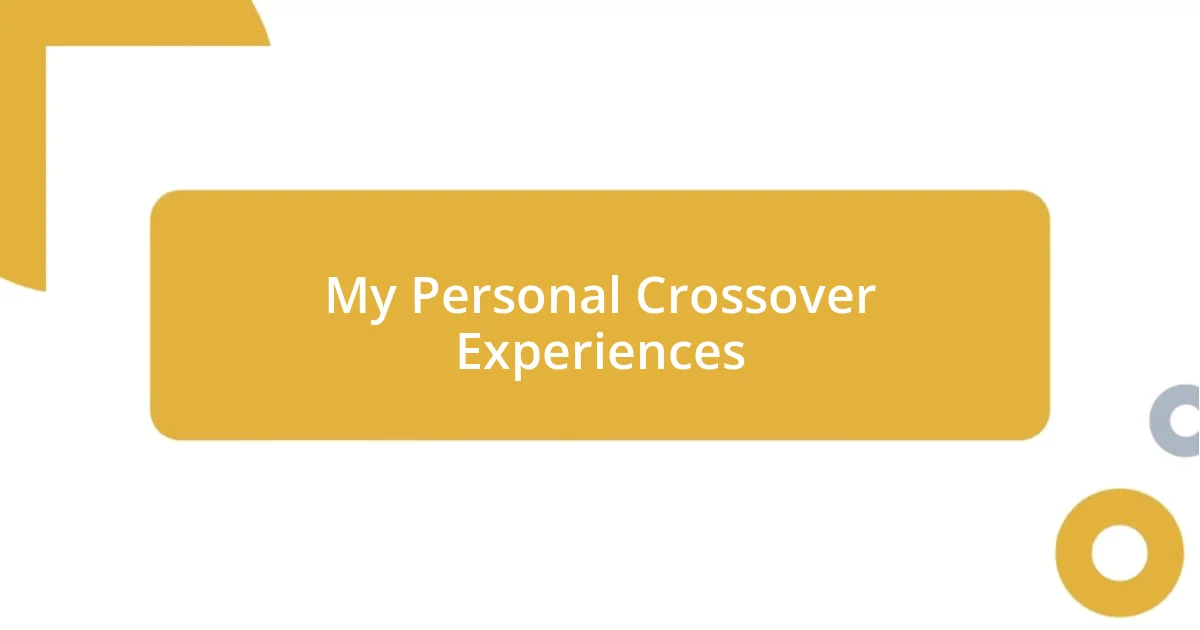
My Personal Crossover Experiences
There was one summer when I found myself completely immersed in a unique crossover between detective fiction and urban fantasy. I remember turning the pages feverishly as the protagonist, a gumshoe with a knack for spell-casting, navigated both shadowy alleys and mystical realms. It was fascinating how the narrative breathed new life into typical tropes of each genre—where solving a murder might also involve battling a rogue spirit. Could anything be more thrilling than a hard-boiled detective who could conjure a spell in a tense moment?
Another memorable experience came from a graphic novel that seamlessly blended science fiction and romance. Here, the characters weren’t just fighting against an oppressive regime; they were also discovering their feelings for each other amidst the chaos. Each time they shared a stolen glance, I felt a spark of nostalgia—reminding me of my first crush while grappling with uncertainties in life. Isn’t it intriguing how love can blossom even in the harshest of landscapes?
I still vividly recall when I discovered a series that merged historical fiction with elements of fantasy. As I read about real events intertwined with magical occurrences, I found myself reevaluating how history could be perceived through different lenses. One particular scene where the main character converses with a legendary figure altered my understanding of both fact and fiction. It puts me in the mindset to question, how much do we really know about the past? That experience not only broadened my horizon but also reinforced how crossover narratives can challenge our perceptions.
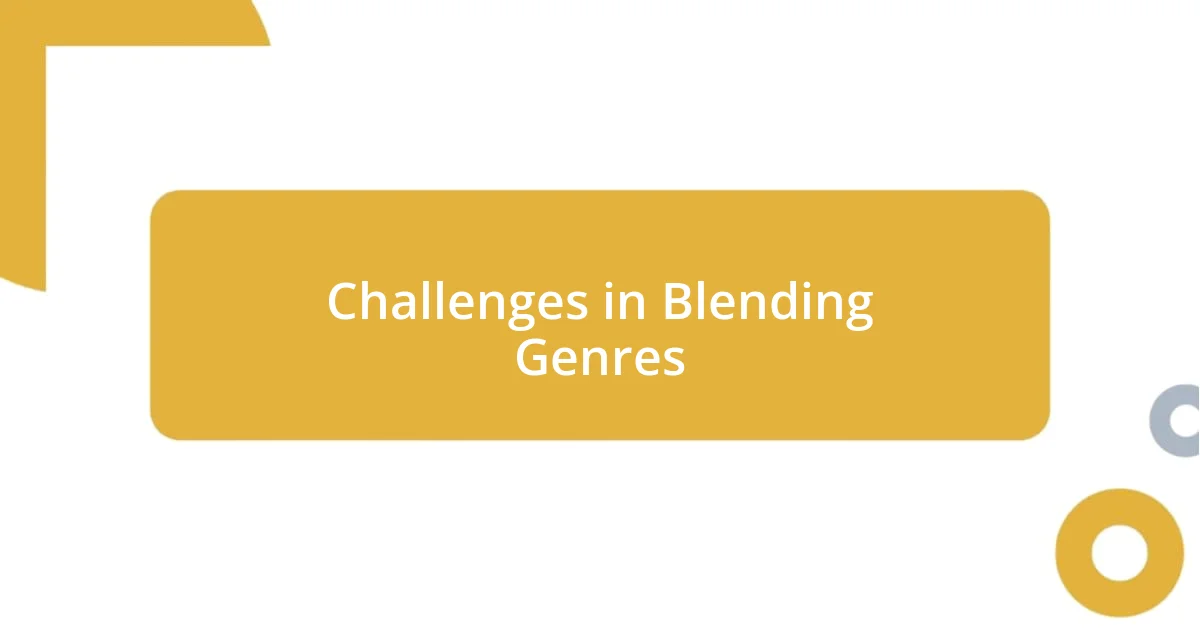
Challenges in Blending Genres
Blending genres presents unique challenges that can make or break a story. I remember attempting to craft a short story that combined elements of horror with fairy tale motifs. It was tricky because I needed to keep the whimsical charm of the fairy tale while infusing it with genuine fear. This delicate balance often left me questioning whether I was leaning too heavily on one side, risking the coherence of the narrative.
One hurdle in merging genres is ensuring that the elements mesh in a way that feels authentic. I once read a novel that tried to mix steampunk with romance, but instead of enhancing the plot, it felt forced. Characters were suddenly shoehorned into technology-driven situations that did not align with their emotional arcs. Have you ever found yourself lost when a story’s voice and elements clash? It can definitely be disheartening when the initial excitement fades due to an awkward fusion.
Moreover, expectations can also create barriers. When I explored a series combining academic drama and supernatural elements, I was caught off guard by how my preconceived notions about both genres skewed my perception. I could feel the frustration as I sought the deeper stakes typically found in academic works, even while wading through the mysticism. The disparity between what I was hoping for and the delivery made me realize that sometimes, our genre expectations can hinder our ability to appreciate the innovation that these crossovers can introduce.

Tips for Successful Crossovers
When diving into a crossover, clarity is crucial. I recall one project where I attempted to weave together horror and comedy. While the premise seemed exciting, I quickly found myself struggling to keep the tone consistent. Have you ever been confused by a story that jumps between moods? It can leave readers bewildered. A successful crossover needs distinct but complementary tones that don’t jolt the audience out of the narrative.
Character development holds enormous weight in crossovers. I remember reading a noir story featuring a time-traveling detective. At first, the blend was entertaining, but as I continued, I realized the character’s motivations fell flat. It led me to question, how can you make characters believable in both worlds? I believe that fully fleshed-out characters with dimensions relatable to both genres help create a bridge for the audience, allowing for a more immersive experience.
Finally, don’t shy away from experimentation. I once wrote a piece merging mythology and dystopian fiction. The initial draft was chaotic, but as I honed it, the bizarre combinations sparked creativity I hadn’t anticipated. It’s thrilling to see how different elements can interact, don’t you think? Embracing that creative curiosity can lead to unexpected revelations that elevate your narrative in ways you might not have imagined.
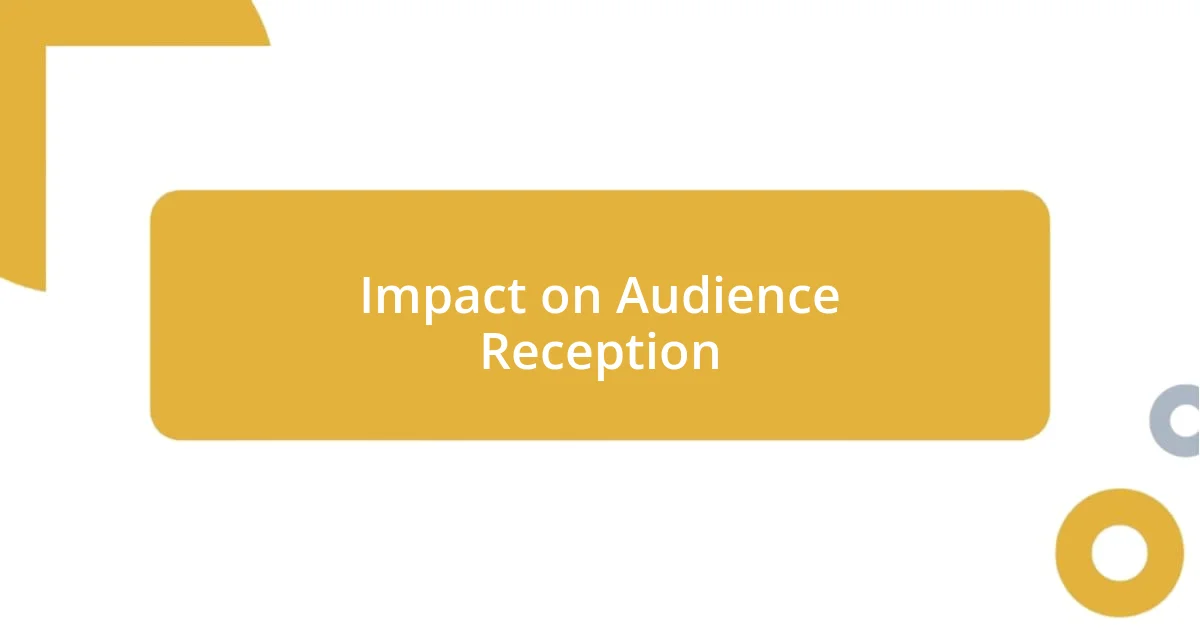
Impact on Audience Reception
Each crossover experience resonates differently with the audience based on their expectations and familiarity with the genres involved. I remember reading a graphic novel that combined horror with a coming-of-age story. Initially, I was excited, but as the plot progressed, I felt torn between the ages of the characters and the chilling events they faced. I wondered, do we gravitate more toward characters or themes? For some, that dark humor was refreshing, but for others, it perhaps felt like a misstep that didn’t pay off.
Audience reception often hinges on how effectively the cross-genre elements are portrayed. For instance, I stumbled across a film that attempted to merge sci-fi with romantic drama. While it had its moments, the sci-fi aspects felt overshadowed by the love story. I couldn’t help but think, does a story risk losing its core audience if one genre overshadows another? It’s a delicate dance that requires finesse, as it may alienate viewers who came for one experience only to find a different emotional journey.
Emotional engagement can be a double-edged sword in cross-genre narratives. In my experience with a web series blending thriller elements with quirky comedy, the humor often provided a necessary distraction from tension. Yet, I also detected moments where the comedic bits undermined the suspense. This made me reflect on how does genre blending impact our emotional connection? I believe that when done right, the interplay can lead to a more nuanced experience, engaging the audience in surprising ways while offering new perspectives on familiar themes.

